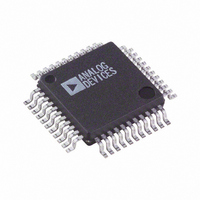AD7859ASZ Analog Devices Inc, AD7859ASZ Datasheet - Page 14

AD7859ASZ
Manufacturer Part Number
AD7859ASZ
Description
IC ADC 12BIT 8CH LP 44-MQFP
Manufacturer
Analog Devices Inc
Datasheet
1.AD7859LASZ.pdf
(28 pages)
Specifications of AD7859ASZ
Data Interface
Parallel
Number Of Bits
12
Sampling Rate (per Second)
200k
Number Of Converters
2
Power Dissipation (max)
30mW
Voltage Supply Source
Analog and Digital
Operating Temperature
-40°C ~ 85°C
Mounting Type
Surface Mount
Package / Case
44-MQFP, 44-PQFP
Resolution (bits)
12bit
Sampling Rate
100kSPS
Input Channel Type
Single Ended
Supply Voltage Range - Analog
3V To 5.5V
Supply Voltage Range - Digital
3V To 5.5V
Lead Free Status / RoHS Status
Lead free / RoHS Compliant
Available stocks
Company
Part Number
Manufacturer
Quantity
Price
Company:
Part Number:
AD7859ASZ
Manufacturer:
Analog Devices Inc
Quantity:
10 000
Part Number:
AD7859ASZ
Manufacturer:
ADI/亚德诺
Quantity:
20 000
Company:
Part Number:
AD7859ASZ-REEL
Manufacturer:
Analog Devices Inc
Quantity:
10 000
AD7859/AD7859L
CIRCUIT INFORMATION
The AD7859/AD7859L is a fast, 8-channel, 12-bit, single sup-
ply A/D converter. The part requires an external 4 MHz/1.8
MHz master clock (CLKIN), two C
signal to start conversion and power supply decoupling capaci-
tors. The part provides the user with track/hold, on-chip refer-
ence, calibration features, A/D converter and parallel interface
logic functions on a single chip. The A/D converter section of
the AD7859/AD7859L consists of a conventional successive-ap-
proximation converter based around a capacitor DAC. The
AD7859/AD7859L accepts an analog input range of 0 to +V
V
nected via a 150 k resistor to the internal 2.5 V reference and
to the on-chip buffer.
A major advantage of the AD7859/AD7859L is that a conver-
sion can be initiated in software, as well as by applying a signal
to the CONVST pin. The part is available in a 44-pin PLCC or a
44-pin PQFP package, and this offers the user considerable
spacing saving advantages over alternative solutions. The
AD7859L version typically consumes only 5.5 mW making it
ideal for battery-powered applications.
CONVERTER DETAILS
The master clock for the part is applied to the CLKIN pin.
Conversion is initiated on the AD7859/AD7859L by pulsing the
CONVST input or by writing to the control register and setting
the CONVST bit to 1. On the rising edge of CONVST (or at
the end of the control register write operation), the on-chip
track/hold goes from track to hold mode. The falling edge of the
CLKIN signal which follows the rising edge of CONVST ini-
tiates the conversion, provided the rising edge of CONVST (or
WR when converting via the control register) occurs typically at
least 10 ns before this CLKIN edge. The conversion takes 16.5
CLKIN periods from this CLKIN falling edge. If the 10 ns set-
up time is not met, the conversion takes 17.5 CLKIN periods.
The time required by the AD7859/AD7859L to acquire a signal
depends upon the source resistance connected to the AIN(+) in-
put. Please refer to the acquisition time section for more details.
When a conversion is completed, the BUSY output goes low,
and the result of the conversion can be read by accessing the
data through the data bus. To obtain optimum performance
from the part, read or write operations should not occur during
the conversion or less than 200 ns prior to the next CONVST
rising edge. Reading/writing during conversion typically de-
grades the Signal-to-(Noise + Distortion) by less than 0.5 dBs.
The AD7859 can operate at throughput rates of over 200 kSPS
(up to 100 kSPS for the AD7859L).
With the AD7859L, 100 kSPS throughput can be obtained as
follows: the CLKIN and CONVST signals are arranged to give
a conversion time of 16.5 CLKIN periods as described above
REF
can be tied to V
DD
. The reference input to the part con-
REF
capacitors, a CONVST
REF.
–14–
and 1.5 CLKIN periods are allowed for the acquisition time.
With a 1.8 MHz clock, this gives a full cycle time of 10 s,
which equates to a throughput rate of 100 kSPS.
When using the software conversion start for maximum
throughput, the user must ensure the control register write op-
eration extends beyond the falling edge of BUSY. The falling
edge of BUSY resets the CONVST bit to 0 and allows it to be
reprogrammed to 1 to start the next conversion.
TYPICAL CONNECTION DIAGRAM
Figure 8 shows a typical connection diagram for the AD7859/
AD7859L. The AGND and the DGND pins are connected
together at the device for good noise suppression. The first
CONVST applied after power-up starts a self-calibration
sequence. This is explained in the calibration section of this data
sheet. Note that after power is applied to AV
the CONVST signal is applied, the part requires (70 ms + 1/
sample rate) for the internal reference to settle and for the self-
calibration on power-up to be completed.
For applications where power consumption is a major concern,
the power-down options can be exercised by writing to the part
and using the SLEEP pin. See the Power-Down section for more
details on low power applications.
+3V TO +5V
0V TO 2.5V
ANALOG
SUPPLY
INPUT
REFERENCE
EXTERNAL
OPTIONAL
DV
0.01µF
10µF
0.1µF
DD
Figure 8. Typical Circuit
0.1µF
REF192
AD780/
AIN(+)
AIN(–)
SLEEP
AGND
C
C
CAL
DGND
REF1
REF2
AV
REF
DD
AD7859L
AD7859/
IN
DV
/REF
DD
0.1nF EXTERNAL REF
0.1µF INTERNAL REF
OUT
0.1µF
CONVST
CLKIN
BUSY
DB15
W/B
DB0
WR
RD
CS
DD
4MHz/1.8MHz
OSCILLATOR
and DV
START SIGNAL
CONVERSION
DD
REV. A
µC/µP
and













